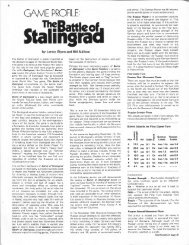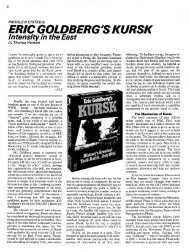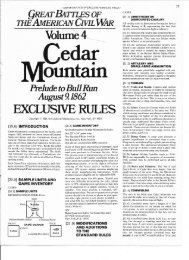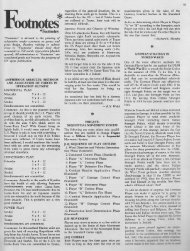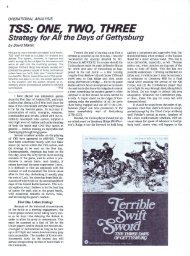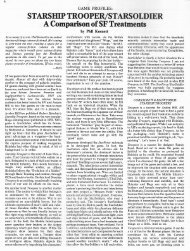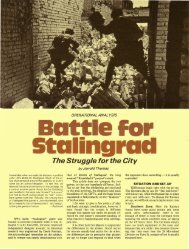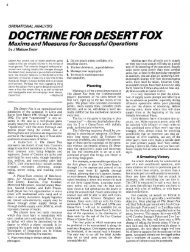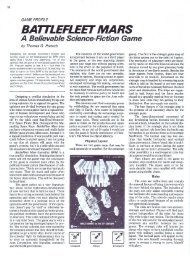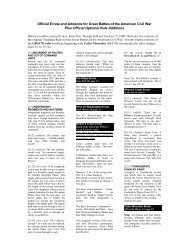Napoleon At Waterloo - Learning SPI's Great Battles of the American ...
Napoleon At Waterloo - Learning SPI's Great Battles of the American ...
Napoleon At Waterloo - Learning SPI's Great Battles of the American ...
You also want an ePaper? Increase the reach of your titles
YUMPU automatically turns print PDFs into web optimized ePapers that Google loves.
24<br />
Grouchy at <strong>Waterloo</strong> by<br />
A.A. No!;<br />
Marshal Grouchy is one <strong>of</strong> <strong>the</strong> people in<br />
history who have assumed <strong>the</strong> role <strong>of</strong><br />
scapegoat over <strong>the</strong> years. Historians <strong>of</strong> <strong>the</strong><br />
<strong>Waterloo</strong> Campaign place much <strong>of</strong> <strong>the</strong> blame<br />
for <strong>Napoleon</strong>'s defeat at <strong>Waterloo</strong> on his<br />
shoulders. The refrain goes something like, "If<br />
Grouchy had brought his troops to <strong>the</strong> support<br />
<strong>of</strong> <strong>Napoleon</strong> at <strong>Waterloo</strong> <strong>the</strong> outcome <strong>of</strong> <strong>the</strong><br />
battle would have been changed." Perhaps. But<br />
one thing is clear: few <strong>of</strong> <strong>the</strong> works on <strong>the</strong><br />
Battle <strong>of</strong> <strong>Waterloo</strong> ever bo<strong>the</strong>r to detail what h<br />
was that Grouchy was actually doing those<br />
fateful June days.<br />
The <strong>Waterloo</strong> Campaign opened on 15 June<br />
1815 when <strong>the</strong> first French troops began<br />
•<br />
crossing <strong>the</strong> Sambre against sharp resistence<br />
from minor Prussian formations. Since<br />
<strong>Napoleon</strong> had "stolen a march" on both <strong>the</strong><br />
Prussians and <strong>the</strong>ir Allies his army managed to<br />
get across in relatively good order and slept on<br />
<strong>the</strong> field <strong>the</strong> night <strong>of</strong> 15·16 June. That night<br />
Blucher, <strong>the</strong> Prussian commander, and<br />
Wellington, <strong>the</strong> Anglo-Allied commander, had<br />
<strong>the</strong>ir exhausted troops marching as best <strong>the</strong>y<br />
could toward <strong>the</strong> French. [Note: In this article<br />
Prussian formations will be in italics for<br />
claritv.l<br />
On 16 June two battles occured, one at Quatre<br />
Bras and one a few miles to <strong>the</strong> east at Llqnv,<br />
<strong>At</strong> Ouatre Bras <strong>the</strong> outcome was basically a<br />
draw, with <strong>the</strong> Anglo-Allied forces left in<br />
possession <strong>of</strong> <strong>the</strong> field largely through French<br />
ineptitude. l.lqnv. however, was a decisive<br />
action. Nearly two-thirds <strong>of</strong> <strong>the</strong> Prussian army<br />
'under' Blucher, were soundly beaten, suffering<br />
about 30,000 casualties out <strong>of</strong> a force <strong>of</strong> no<br />
more than 85,000.<br />
The broken, roadless terrain about Llqnv ,<br />
coupled with <strong>the</strong> lateness <strong>of</strong> <strong>the</strong> hour<br />
prevented an effective pursuit <strong>of</strong> <strong>the</strong> Prussians.<br />
Still, <strong>Napoleon</strong> sent I Cavalry Corps scouting<br />
nor<strong>the</strong>ast toward Namur along <strong>the</strong> Prussian<br />
line <strong>of</strong> communication. II Cavalry Corps was<br />
instructed to scout in <strong>the</strong> general direction <strong>of</strong><br />
Gembloux, a possible alternative line <strong>of</strong><br />
communication for <strong>the</strong> Prussians and a small<br />
force <strong>of</strong> cavalry was sent <strong>of</strong>f toward Tilly to<br />
try to determ ine whe<strong>the</strong>r <strong>the</strong> Prussians had<br />
fallen back that way.<br />
The respite given <strong>the</strong>m by nightfall enabled <strong>the</strong><br />
Prussians to recover <strong>the</strong>ir strength and<br />
cohesion somewhat. Blucher's chief <strong>of</strong> staff<br />
ordered <strong>the</strong> remnants <strong>of</strong> , and /I Corps (C.<br />
30,000 men) to withdraw towards Tilly while<br />
"' Corps (c. 20,000 men) was to retreat<br />
towards Gembloux. Meanwhile, Bulow's 'V<br />
Corps (c. 30,000 men and 88 guns) was<br />
marching up from Liege. This corps was <strong>the</strong><br />
only undamaged element in <strong>the</strong> Prussian<br />
Army, having missed <strong>the</strong> Battle <strong>of</strong> l.lqnv. Early<br />
on 17 June <strong>the</strong> lead elements <strong>of</strong> 'V Corps<br />
linked up with "' Corps.<br />
Bulow assumed command <strong>of</strong> /I, Corps and<br />
marched both formations towards Wavre on<br />
his own initiative. <strong>At</strong> 1020 this move was<br />
confirmed by Blucher. This was probably <strong>the</strong><br />
single most important strategic decision made<br />
by <strong>the</strong> Allies in <strong>the</strong> <strong>Waterloo</strong> Campaign.<br />
By retreating towards Wavre, Blucher abandoned<br />
his line <strong>of</strong> comrnunication, cutting his ties<br />
with his b~se at Liege and his line <strong>of</strong> retreat<br />
back into Prussia. Though badlv defeated, <strong>the</strong><br />
semi-senile, septuagenarian Blucher was willing<br />
to have ano<strong>the</strong>r go at <strong>Napoleon</strong> ra<strong>the</strong>r than<br />
quit. By this decision he completely altered<br />
<strong>the</strong> strategic situation.<br />
While Blucher was retreating, <strong>the</strong> French<br />
cavalry was beginning to report to <strong>Napoleon</strong>.<br />
All reports seemed to indicate that <strong>the</strong><br />
Prussians were broken and falling back towards<br />
Prussia. The thousands <strong>of</strong> straggling troops<br />
jamming <strong>the</strong> roads towards Prussia seemed to<br />
confirm this conclusion and <strong>Napoleon</strong> <strong>the</strong>refore<br />
assumed it was true. To ensure <strong>the</strong> defeat<br />
<strong>of</strong> <strong>the</strong> Prussians he entrusted some 33,000<br />
troops to Marshal Grouchy and ordered him to<br />
maintain a strong pursuit but to retain his<br />
freedom <strong>of</strong> movement. Since word from<br />
Quatre Bras indicated that <strong>the</strong> situation <strong>the</strong>re<br />
was still inconclusive, <strong>Napoleon</strong> took <strong>the</strong><br />
balance <strong>of</strong> his Right Wing with him-although<br />
inexplicably leaving one full division at St.<br />
Amand and marched to Ouatre Bras. Grouchy<br />
was on his own.<br />
There were heavy rains all that day and <strong>the</strong>se,<br />
combined with poor staff work resulted in <strong>the</strong><br />
gradual loss <strong>of</strong> contact between Grouchy's<br />
cavalry patrols and <strong>the</strong> retreating Prussians.<br />
<strong>At</strong>tempts to re-establish contact were frustrated<br />
by <strong>the</strong> wea<strong>the</strong>r and by 1900 Grouchy qave<br />
up and bedded his troops down in <strong>the</strong> vicinity<br />
<strong>of</strong> Gembloux. Here he conveyed to <strong>Napoleon</strong><br />
incorrect reports from his scouts that <strong>the</strong><br />
Prussians had broken into two columns, one<br />
falling back on Liege and <strong>the</strong> o<strong>the</strong>r on Wavre.<br />
He indicated that he would pursue <strong>the</strong> larger,<br />
which appeared to be headed for Wavre. This<br />
evaluation <strong>of</strong> <strong>the</strong> situation was completely<br />
wrong. The' entire Prussian Army was falling<br />
back on Wavre. The troops seen heading for<br />
Liege were a large, disordered mass <strong>of</strong><br />
stragglers. The situation was serious since <strong>the</strong><br />
Prussians were reconcentrating but <strong>the</strong> French<br />
didn't know it.<br />
Blucher reached Wavre with most <strong>of</strong> his army<br />
<strong>the</strong> night <strong>of</strong> 17-18 June, while Grouchy's<br />
troops slept. Early <strong>the</strong> next morning he<br />
ordered his forces, by now numbering around<br />
80,000 men, to join Wellington's forces in <strong>the</strong><br />
vicinity <strong>of</strong> Mont-St.-Jean. The march was late<br />
in getting started because a massive traffic jam<br />
ensued which took hours to clear up.<br />
Grouchy, meanwhile, delayed his morning<br />
orders and did not finally move out until<br />
0730. With II Caval ry Corps scouting ahead<br />
and I Cavalry Corps covering his left and<br />
attempting to link up with <strong>Napoleon</strong> and <strong>the</strong><br />
main body, he advanced on Wavre with his two<br />
infantry corps. Some historians have stated<br />
that <strong>Napoleon</strong> ordered Grouchy on this<br />
morning to fallon Wellington's flank if <strong>the</strong><br />
opportunity presented itself. While <strong>the</strong>re exists<br />
no evidence substantiating this order, it is<br />
reasonable to assume that, if it was issued,<br />
<strong>Napoleon</strong> expected Grouchy to recognize that<br />
his primary mission was to keep between<br />
Blucher and Wellington at all times. But this is<br />
precisely what Grouchy failed to do.<br />
Advancing carefully but agressively Grouchy's<br />
cavalry encountered and skirmished for about<br />
an hour with elements <strong>of</strong> Prussian /I Corps<br />
below Wavre beginning about 0930. Prisoners<br />
revealed that Blucher was sending <strong>the</strong> bulk <strong>of</strong><br />
<strong>the</strong> Prussian Army to join Wellington, and <strong>the</strong><br />
commander <strong>of</strong> II Cavalry Corps lrnmedlatelv<br />
dispatched this unpleasant information to<br />
Grouchy. By this time Grouchy had reached<br />
The terloo Campaign Key:<br />
I......J Prussian and Allied Positions,<br />
;1600, 18 June 1815<br />
-+ French Movements, 16-18 June<br />
o French Positions, 16 June
25<br />
Walhain with III Corps and IV Corps was just a<br />
little behind. Settling down for lunch, <strong>the</strong><br />
Marshal's mess was disturbed at 1130 by <strong>the</strong><br />
sound <strong>of</strong> artillery fire coming from <strong>the</strong><br />
direction <strong>of</strong> Mont-St.-Jean, about a dozen<br />
miles to <strong>the</strong> northwest. The commander <strong>of</strong> IV<br />
Corps and several o<strong>the</strong>r senior <strong>of</strong>ficers<br />
demanded that Grouchy immediately move to<br />
support <strong>Napoleon</strong>, who was obviously engaged<br />
in a major battle. Grouchy refused, pointing<br />
out that his orders required him to pursue <strong>the</strong><br />
Prussians. Had he moved at this point he<br />
would probably have arrived on <strong>Napoleon</strong>'s<br />
right flank about 1900 hours, just in time to<br />
fallon <strong>the</strong> Prussian IV Corps as it engaged<br />
<strong>Napoleon</strong>'s troops near Placenolt and also in<br />
time to support <strong>the</strong> attack <strong>of</strong> <strong>the</strong> Old Guard.<br />
Undoubtedly, Grouchy could have influenced<br />
<strong>the</strong> course <strong>of</strong> <strong>the</strong> battle, but it is not<br />
necessarily <strong>the</strong> case that his arrival would have<br />
turned <strong>Waterloo</strong> into a French victory. The<br />
luncheon went on, only to be interrupted<br />
again at 1230 when <strong>the</strong> messenger from II<br />
Cavalry Corps finally arrived, having taken two<br />
hours to cover about six miles. He told<br />
Grouchy that <strong>the</strong> Prussians were preparing to<br />
fallon <strong>Napoleon</strong>'s flank.<br />
Grouchy immediately, and belatedly, moved<br />
into action. I Cavalry Corps was ordered to<br />
take <strong>the</strong> village <strong>of</strong> Limale followed by IV<br />
Corps, while III Corps marched for Wav're<br />
screened by II Caval ry Corps.<br />
Holding <strong>the</strong> Iine <strong>of</strong> <strong>the</strong> Dyle River, between<br />
Limale and Wavre, was Prussian III Corps (c.<br />
17,000). Fighting began at 1630, when II<br />
Cavalry Corps arrived in front on Wavre,<br />
closely followed by III Corps. The French<br />
cleared <strong>the</strong> nearslde <strong>of</strong> <strong>the</strong> river handily but<br />
got into a difficult position doing so. From <strong>the</strong><br />
heights <strong>of</strong> <strong>the</strong> left bank Prussian batteries sh ot<br />
up <strong>the</strong> French badly. Although <strong>the</strong> Prussian<br />
defense was improvised it was highly effective.<br />
Ironically if <strong>the</strong> French had delayed a bit<br />
longer <strong>the</strong> Prussians would have been out <strong>of</strong><br />
<strong>the</strong> position entirely, marching for <strong>Waterloo</strong>.<br />
Indeed, one brigade had already marched <strong>of</strong>f,<br />
but had been replaced by a wayward brigade<br />
<strong>of</strong> I Corps which took up position in Limale.<br />
Meanwhile, Blucher, by this time closer to<br />
<strong>Waterloo</strong> than to <strong>the</strong> action at Wavre, had a<br />
difficult time convincing his <strong>of</strong>ficers to<br />
continue to march to support Wellington.<br />
Fortunately for <strong>the</strong> Allies, he was successful.<br />
Unlike Grouchy, Blucher recognized what his<br />
primary mission was and did not permit<br />
secondary considerations to influence his<br />
judgement. Defeating <strong>Napoleon</strong> was far more<br />
important than <strong>the</strong> fate <strong>of</strong> one corps at Wavre.<br />
hi le Blucher was making this decision, <strong>the</strong><br />
situation along <strong>the</strong> Dyle grew heated and<br />
bloody. In a short time I and II Cavalry Corps<br />
and III Corps were hotly engaged and IV Corps<br />
vas moving up rapidly, though because <strong>of</strong> a<br />
confusion in orders it was turning up at Wavre<br />
ra<strong>the</strong>r than Limale. <strong>At</strong> 1700 Grouchy finally<br />
received orders from <strong>Napoleon</strong> to assist <strong>the</strong><br />
main body at <strong>Waterloo</strong>. Ordering III Corps and<br />
II Caval ry Corps to keep up <strong>the</strong> pressu re at<br />
Vavre, Grouchy assembled IV Corps and<br />
marched for Limale, but not before wasting<br />
more time by making one final attempt to take<br />
Vavre.<br />
t Limale I Cavalry Corps, supported by a<br />
cavalry division from IV Corps, had just<br />
9JCeeded in siezing <strong>the</strong> village at <strong>the</strong> charge<br />
'<strong>the</strong>n Grouchy arrived with <strong>the</strong> balance <strong>of</strong> IV<br />
Corps. The Prussians made a serious effort to<br />
ratake <strong>the</strong> place but were repu lsed by IV Corps<br />
<strong>Napoleon</strong><br />
at <strong>Waterloo</strong>:<br />
Some Variant Scenarios<br />
or Marshal Grouchy to <strong>the</strong> Rescue?<br />
If Grouchy had performed more competently<br />
at <strong>Waterloo</strong> he might have gone<br />
down as one <strong>of</strong> history's greatest "clutch<br />
players." This module enables players to<br />
modify <strong>SPI's</strong> <strong>Napoleon</strong> at <strong>Waterloo</strong> to<br />
include a burst <strong>of</strong> genius on Grouchy's part.<br />
Additional pieces needed for <strong>the</strong> modified<br />
game are shown in <strong>the</strong> Reinforcement Unit<br />
Chart. These may be made from blank<br />
counters or 'players may cannibalize a set <strong>of</strong><br />
NA W counters and select units <strong>of</strong><br />
equivalent strength. To use <strong>the</strong> secret "die<br />
roll" tables players should each tear up a<br />
small sheet <strong>of</strong> paper into six pieces, number<br />
<strong>the</strong> pieces 1 to 6 and select one from a<br />
container held by <strong>the</strong> opposing player. each<br />
player should keep his number secret until<br />
<strong>the</strong> time comes when <strong>the</strong> results <strong>of</strong> it apply<br />
to <strong>the</strong> game.<br />
"No Change", <strong>of</strong> course, indicates that <strong>the</strong><br />
player in question must get along with his<br />
basic forces. For <strong>the</strong> French, this means <strong>the</strong><br />
troops actually on <strong>the</strong> mapsheet, for <strong>the</strong><br />
Allies this means <strong>the</strong> troops pn <strong>the</strong><br />
mapsheet and <strong>the</strong> regular contingent <strong>of</strong><br />
Purssians arriving turn 2.<br />
The outcomes which provide for a reduced<br />
or late arriving Prussian contingent, or no<br />
Prussian contingent at all, indicate merely<br />
that Marshal Grouchy has managed to hold<br />
<strong>the</strong> Prussians in place somewhere east <strong>of</strong><br />
<strong>the</strong> main battle area. [Prussian outcomes 2,<br />
3 and 4].<br />
The outcomes which provide for increased<br />
Prussian contingents [Prussian outcomes 5<br />
and 6] indicate that Grouchy was more<br />
incompetent that usual and managed to let<br />
all <strong>of</strong> <strong>the</strong> Prussians slip through his fingers.<br />
French outcomes 4 and 5 provide for <strong>the</strong><br />
possibility that Grouchy heeded General<br />
Gerard's demands that his corps be<br />
immediately dispatched to support <strong>Napoleon</strong>.<br />
French outcome 6 indicates that <strong>the</strong><br />
Marshal made <strong>the</strong> right choice and<br />
managed to come on with all his forces.<br />
REINFOP4CEMENT<br />
CHART<br />
Additional French Units<br />
(under <strong>the</strong> command<br />
<strong>of</strong> Marshal Grouchy)<br />
~.<br />
10[8;J<br />
[;J'<br />
B[8;J 11[8;J 12[8;J<br />
6-4 5-4 ffiJ' 5-4 ~' 5-4<br />
~.~~<br />
~~~<br />
~~r:cn~<br />
~~~~<br />
~~<br />
l2:U~<br />
Obviously, <strong>the</strong> outcomes will occur in<br />
patterns, complementing each o<strong>the</strong>r. Thus<br />
if Prussian outcome 5 combines with<br />
French outcome 1 it means that Grouchy<br />
has managed to get himself totally lost. On<br />
<strong>the</strong> o<strong>the</strong>r hand, Prussian outcome 2<br />
combined with French outcomes 4 or 5<br />
mean that <strong>the</strong> Marshal has managed a<br />
brilliant holding action. And if combined<br />
with outcome 6 it means that he has proven<br />
to be one <strong>of</strong> <strong>the</strong> finest generals <strong>of</strong> <strong>the</strong> age.<br />
'4.<br />
Secret "Die Roll" Tables<br />
Allies<br />
1. No change.<br />
2. No Prussian reinforcements arrive at any<br />
time.<br />
3. Regular Prussian reinforcements arrive<br />
on turn 4, ra<strong>the</strong>r than turn 2.<br />
4. Prussian reinforcements arrive on turn 2<br />
but only one 5-4, one 4-4, one 3-5, and<br />
one 3-3.<br />
5. Regular Prussian contingent arrives on<br />
turn 2 and additional reinforcements <strong>of</strong><br />
one 5-4, one 4-4, one 3-5 and one 3-3<br />
arrive on turn 4.<br />
6. Regular Prussian contingent arrives on<br />
turn 2, and all additional Prussian reinforcements<br />
arrive turn 4.<br />
French<br />
1. No change<br />
2. No change.<br />
3. No change.<br />
French Player receives on 5-4, two 4-4's,<br />
one 2-5, and one 3-3 turn 4.<br />
5. French Player receives one 5-4, two<br />
4-4's, one 2-5, and one 3-3 turn 4.<br />
6. All French reinforcements shown on <strong>the</strong><br />
Reinforcement Chart arrive 'turn 4.<br />
All reinforcements arrive anywhere on <strong>the</strong><br />
eastern edge <strong>of</strong> <strong>the</strong> mapsheet, not more<br />
than five hexes apart from each 'o<strong>the</strong>r,<br />
Reinforcements not taken in one turn may<br />
be taken in <strong>the</strong> next.<br />
Additional<br />
Prussian Units<br />
(remnants <strong>of</strong> <strong>the</strong> 1st, 2nd and 3rd<br />
Prussian Corps)<br />
mm~m<br />
~~~~<br />
I~II~51<br />
~<br />
~
26<br />
-<br />
and <strong>the</strong> fighting died down shortly after <strong>the</strong><br />
French siezed a major ridge a few hu ndred<br />
yards west <strong>of</strong> <strong>the</strong> town at about 2300.<br />
The next morning Grouchy renewed <strong>the</strong> battle<br />
and Prussian III Corps was soundly beaten. But<br />
<strong>the</strong>n it was too late. Grouchy learned <strong>the</strong><br />
results <strong>of</strong> <strong>Waterloo</strong> at 1030. Rejecting a<br />
prepostrous suggestion that he fallon <strong>the</strong><br />
Allied rear he decided to retreat through<br />
Namur.<br />
Masterfully breaking <strong>of</strong>f action at Limale and<br />
Wavre, Grouchy carried Namur by 1600 and<br />
camped <strong>the</strong>re for <strong>the</strong> night. Early on 20 June<br />
Prussian 1/ Corps attacked but was repulsed.<br />
Later that same day, as his troops were<br />
evacuating <strong>the</strong> town, <strong>the</strong> Prussians renewed<br />
<strong>the</strong>ir attempt to destroy him but suffered<br />
some 1,500 casualties at <strong>the</strong> hands <strong>of</strong> <strong>the</strong><br />
rearguard infantry division. Finding Grouchy<br />
too tough a nut to crack, <strong>the</strong> Prusslans gave up<br />
and marched away to besiege some French<br />
frontier fortresses. The next morning he<br />
brought over 25,000 undefeated troops into<br />
Philippeville where, finding that <strong>the</strong> main army<br />
had already left, he paused only briefly.<br />
Grouchy arrived at Soissons on 25 June and<br />
joined Marshal Soult in an attempt to save<br />
something from <strong>the</strong> wreck. Toge<strong>the</strong>r <strong>the</strong>y had<br />
some 55,000 troops and Grouchy assumed<br />
command on orders from <strong>Napoleon</strong>. Having no<br />
o<strong>the</strong>r choice he marched <strong>of</strong>f towards Paris<br />
hotly pursued by Blucher's Prussians, now<br />
reduced to about 65,000 men. During this<br />
retreat Grouchy's troops engaged, and generally<br />
got <strong>the</strong> better <strong>of</strong>, <strong>the</strong> Prussians in a handful<br />
<strong>of</strong> small battles. On 29 June Grouchy's army<br />
marched into Paris.••<br />
Order <strong>of</strong> Battle<br />
The <strong>Battles</strong> <strong>of</strong> Wavre and Limale<br />
18 June 1815<br />
Xll<br />
QDJ<br />
II<br />
~Irrll<br />
oII<br />
11.1<br />
French I Grouchy I c. 33,000 men<br />
XII<br />
c. 100 guns<br />
Prussian<br />
I<br />
Xll<br />
@J<br />
" I<br />
Xll<br />
[2J<br />
Xl<br />
-[2J<br />
oII<br />
This outline order <strong>of</strong> battle represents<br />
Grouchy's command throughout <strong>the</strong><br />
period from 17 June, when <strong>Napoleon</strong><br />
assigned him <strong>the</strong> task <strong>of</strong> pursuing <strong>the</strong><br />
Prussians, through 25 June, when he<br />
joined his forces with those <strong>of</strong> Soult at<br />
Soissons. For <strong>the</strong> Prussians only <strong>the</strong> corps<br />
actually engaged at Wavre and Limale are<br />
noted. Normally a French corps had a<br />
I<br />
•• I<br />
[2J11<br />
~~<br />
o<br />
!JIO<br />
I<br />
c. 17,000 men<br />
c. 40 guns<br />
r<br />
[!]<br />
cavalry division attached but in <strong>the</strong> case <strong>of</strong><br />
III Corps this was missing. Similarly, I<br />
Cavalry Corps ought to have had two<br />
cavalry divisions, but instead had one only<br />
plus a stray division from ano<strong>the</strong>r corps.<br />
A Prussian corps had no divisional<br />
structure, each brigade being almost as<br />
large as most French divisions.<br />
Grenadier<br />
•<br />
Tactical Warfare: 1680-1850<br />
Tactical game <strong>of</strong> musket-bayonet warfare.<br />
• Sixteen famous battles are depicted ...<br />
• Covering warfare from Blenheim to Palo Alto.<br />
Grenadier is a company / battery / squadron<br />
scale game <strong>of</strong> warfare in <strong>the</strong> period <strong>of</strong> <strong>the</strong><br />
dominance <strong>of</strong> cannon and- musket. The game<br />
depicts sixteen famous battles from <strong>the</strong> introduction<br />
<strong>of</strong> <strong>the</strong> bayonet to <strong>the</strong> invention <strong>of</strong><br />
r if linq. Because <strong>of</strong> <strong>the</strong> tactical scale <strong>of</strong><br />
Grenadier some <strong>of</strong> <strong>the</strong> battles are represented<br />
by crucial segments. isolated and simu lated.<br />
For example. <strong>the</strong> Battle <strong>of</strong> <strong>Waterloo</strong> (1815) is<br />
represented by <strong>the</strong> attach <strong>of</strong> <strong>Napoleon</strong>'s Old<br />
Guard on <strong>the</strong> center <strong>of</strong> <strong>the</strong> British line. The<br />
Battle <strong>of</strong> <strong>the</strong> Pyramids (1798) is represented<br />
by <strong>the</strong> attack <strong>of</strong> <strong>the</strong> Marneluke cavalry on <strong>the</strong><br />
most exposed French infantry. Several o<strong>the</strong>r<br />
battles such as Palo Alto (1846) from <strong>the</strong><br />
Mexican War are covered entirely. Commanders<br />
represented include Marlborough.<br />
Frederick <strong>the</strong> <strong>Great</strong>. <strong>Napoleon</strong>. Nev , Wellington,<br />
and Zachary Taylor. Some <strong>of</strong> <strong>the</strong> 16<br />
battles depicted in Grenadier are Blenheim,<br />
Austerlitz. Marengo. and Jena. <strong>At</strong>tacks are<br />
divided into fire (musket and cannon) and<br />
shock (bayonet and sabre) modes. There are<br />
nine types <strong>of</strong> infantry units. three cavalry and<br />
five artillery. Grenadier's combat resolution<br />
system depends less on chance (die rolls) than<br />
any game yet developed. Available from<br />
Simulations Publications for $6.00.



